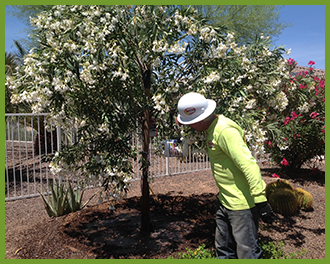 Winter is coming, and this means cooler temperatures are headed our way. Our upcoming winter also means that we need to start adjusting water timers for cooler temperatures so that our trees, shrubs and other plants can thrive during this season. We can also do other things to help prepare our yard for cooler weather. Taking the proper steps to protect our trees and plants from the cooler temperatures ensures that they are ready for spring, which will be here before you know it! Don’t wait to get your yard ready for cooler temperatures. Here are some tips to get your yard ready for the winter from our nursery professionals!
Winter is coming, and this means cooler temperatures are headed our way. Our upcoming winter also means that we need to start adjusting water timers for cooler temperatures so that our trees, shrubs and other plants can thrive during this season. We can also do other things to help prepare our yard for cooler weather. Taking the proper steps to protect our trees and plants from the cooler temperatures ensures that they are ready for spring, which will be here before you know it! Don’t wait to get your yard ready for cooler temperatures. Here are some tips to get your yard ready for the winter from our nursery professionals!
When winter comes, we experience colder days and less sunlight. These types of conditions can cause the soil to stay moist for a more extended period. From November to February, we recommend decreasing the number of times you water your trees and plants.
Tip: Factors such as water, plant maturity, type of plant/tree, and soil types affect where to water, how much to water, how fast and how often to apply the water.
What Time Should I Water?
Our experts recommend watering in the morning, as this is when the ground is at its coldest point. In the morning, the temperatures are cooler, and the air is calmer so that these kinds of conditions will keep evaporation to a minimum. And let’s face it, the morning is the perfect time to get out and enjoy our garden!
How Much Water Should I Use?
Knowing the proper watering depths is critical. The goal is to apply enough water so that it can wet the soil. We recommend using a pointed metal rod so that you can test how deep you have watered. Insert the rod into the ground right after watering. You’ll know you have added the proper amount of water if the rod slides effortlessly through the wet soil and becomes difficult to push once it hits the dry soil. For trees, the proper water depth is 3 feet, shrubs 2 feet, and flowers should be 12 – 18-inches.
 Where Should I Water?
Where Should I Water?
For best results, our experts recommend watering around the tree and not just at the base. We also recommend using Super Charged Moon Juice, which can help accelerate moisture intake so that it also provides the vital nutrients for optimal growth. Using our Moon Juice can also help protect our trees and plants from the colder weather so that they can get a head start when spring comes. Be sure to apply the water only as fast as the soil can absorb it. Adding water too quickly can cause erosion, is a waste of water and compacts the surface of the soil.
Watering New Trees in California (0 – 2 Years from Planting):
Low Water and Waterwise Varieties: Fall: water 1x per week / Winter: water 1x every ten days
Moderate Water Use Varieties: Fall: water 2x a week / Winter: 1x per week
Watering Existing Trees in California (2+ Years from Planting):
Low Water and Waterwise Varieties: Fall: water 1x every ten days / Winter: water 1x every 14 -21 days
Moderate Water Use Varieties: Fall: water 1x every ten days / Winter: 1x every 14 days
Watering New Trees in Arizona and Nevada (0 – 2 Years from Planting):
Low Water and Waterwise Varieties: Fall: water 1x per week / Winter: water 1x every ten days
Moderate Water Use Varieties: Fall: water 2x a week / Winter: 1x per week
Tropical Varieties: Fall: 2x per week / Winter: 1x per week
Watering Existing Trees in Arizona and Nevada (2+ Years from Planting):
Low Water and Waterwise Varieties: Fall: water 1x every ten days / Winter: water 1x every 14 - 21 days
Moderate Water Use Varieties: Fall: water 1x every ten days / Winter: 1x every 14 days
Tropical Varieties: Fall: 1x per week / Winter: 1x every 10 – 14 days
Protect Your Trees and Plants
While our temperatures tend to stay on the comfortable side, we do get those nights and days when the temperatures drop to freezing or frost conditions. When temperatures dip this low, we recommend covering your plants with a frost cloth. A frost cloth can help insulate your trees and plants and can also help them retain ambient heat that comes from the soil. You can also use burlap or other cloth materials. However, NEVER USE A PLASTIC COVER because plastic material increases the chance of freeze damage! Once the sun rises and the temperature has risen above freezing, remove the cover! Once the sun rises and the temperature has risen above freezing, remove the cover.

Submit a Comment